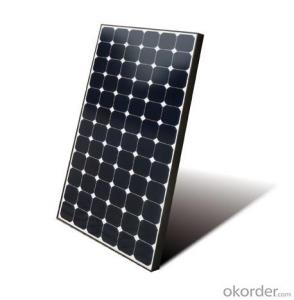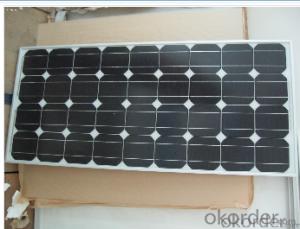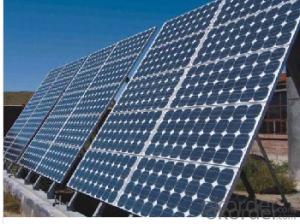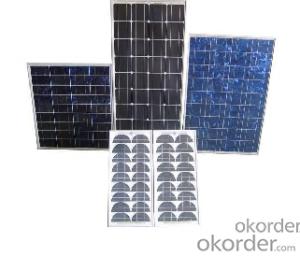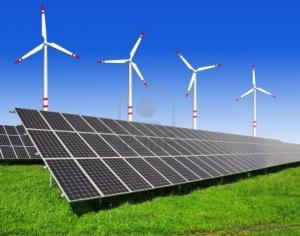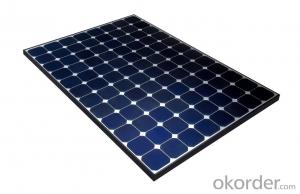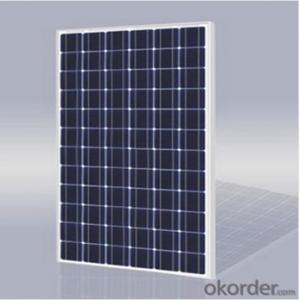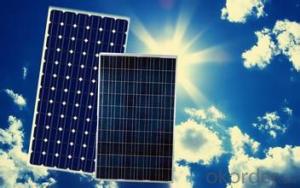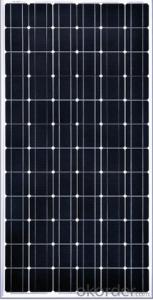Elon Solar Panels 50w CNBM Monocrystalline Silicon Panel for Home Use
- Loading Port:
- Qingdao
- Payment Terms:
- TT OR LC
- Min Order Qty:
- 100 watt
- Supply Capability:
- 1000 watt/month
OKorder Service Pledge
OKorder Financial Service
You Might Also Like
Specification
50W CNBM Monocrystalline Silicon Panel for Home Using
Production description
Most solar modules are currently produced from crystalline silicon (c-Si) solar cells made of multicrystalline andmonocrystalline silicon. In of gallium arsenide (GaAs) and other semiconductor materials. Another emerging PV technology using MJ-cells is concentrator photovoltaics (CPV).
The efficiency of a module determines the area of a module given the same rated output – an 8% efficient 230 watt module will have twice the area of a 16% efficient 230 watt module. There are a few solar panels available that are exceeding 19% efficiency. A single solar module can produce only a limited amount of power; most installations contain multiple modules. A photovoltaic system typically includes a panel or an array of solar modules, a solar inverter, and sometimes a battery and/or solar tracker and interconnection wiring.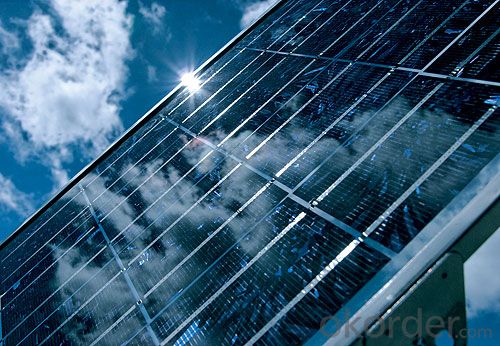
Feature
1.High conversion efficiencies resulting in superior power output performance.
2.Outstanding power output even in low light or high temperature conditions
3.Optimized design for ease of soldering and lamination
4.Long-term stability,reliability and performance
5.Low breakage rate
6.Color uniformaity
Physical characteristic
1. Rigorous quality control meets the highest international standards.
2. High-transmissivity low-iron tempered glass, strong aluminium frame.
3. Using UV-resistant silicon.
4. IS09001/14001/CE/TUV/UL
- Q: I'm writing a post-apocalyptic story in it the main character finds a warehouse. Eventually he finds out the roof is covered with commercial solar panels. Given it's been over a year since the majority of the world died no manainence was done, do they still work?
- they are in a position to be in case you're properly knowledgeable and experienced of their assembly and working function, offered you acquire the comparable severe high quality grade cells and do perfect assembly. probability is robust although that your first a number of could be in hassle-free terms somewhat below par till you rather get the carry of it and strengthen into properly practiced purely because of the fact the pros are. Does take a important volume of grunt paintings although so determine if it rather is great use of a while or in case you will do greater beneficial to earn at your prevalent paintings and pay a professional to do this which they do superb.
- Q: Why can not the solar panel load directly?
- Solar panels because of low power, and the output voltage is extremely unstable, not suitable for load.
- Q: Am using 800watts sukam inverter and have 55watts panel. What controller can i use to connect my solar system to have a max power . Already i have 200 Amp/hr battery
- You need a charger Controller but 55 watt panel is not a whole lot of power. So yes you can buy a very good one but it will cost a lot more. For a 55 watt panel you only need a 4 to 7 amp controller. But why not buy a 0 amp so you can add a second solar panel etc... A PWM (Pulse Width Modulated) is the cheapest and most robust type MPPT (Maximum Power Point Tracking) These controllers actually detect the optimum operating voltage and amperage of the solar array and match that with the battery bank. The result is additional 5-30% more power out of your array versus a PWM controller So unless you have a system over 200 watt the PWM works very good I have two of the PWM myself
- Q: How much solar energy does a 2m by a 3m solar panel convert to energy on a sunny day? Assume that the solar cells are 30% efficient.I'm not looking for the answer so much as I need an explanation o how to solve this type of problem... Thanks!!
- You have the area of the solar panel. You know their efficiency. What you need to know now is the energy (per area) delivered by the sun. The energy delivered by the sun can be found on the internet. Earth ,43 – ,32 W/m? (wikipedia) That is offcourse for your solar panels perpendicular to the ray's of the sun. If they are under an angle you should see what the area of the projecton of your solar panel is on a plane perpendicular to the ray's of the sun. So know you have the intensity W/m? and an area (or effective area). Here you go the energy deliverd by the sun. And 30% of it is what you get out of your panels.
- Q: Can solar panels be installed on agricultural irrigation systems?
- Yes, solar panels can be installed on agricultural irrigation systems. They can provide a sustainable and renewable source of energy to power irrigation pumps, reducing reliance on fossil fuels and lowering operational costs for farmers. Additionally, solar panels are compatible with various irrigation system configurations and can be easily integrated to support the water needs of crop production.
- Q: Are photovoltaic cells the same as solar panels?
- All okorder
- Q: Have a 20V 40W solar panel and it is attach to two backup batteries. Just want to know know how many watt of inverter do I need?
- It depends on what you want to run from the panel. A 20W inverter might last a long time, but would not run much. A 00W inverter might run down your batteries in a few hours. It might help if you posted how much capacity (Volts, Amp-Hours) the batteries have.
- Q: Can solar panels be used to power a drone?
- Yes, solar panels can be used to power a drone. By integrating solar panels onto the surface of a drone, the panels can convert sunlight into electrical energy, which can be used to power the drone's motors and other electronic components. This allows for extended flight times and increased sustainability as the drone can harness renewable energy from the sun.
- Q: I'm trying to charge rechargeable AA batteries with a solar panel. What gauge wire should I use to connect the panel to the batteries? I know I'm not going to have a lot of current going through so the wire size doesn't really matter. Can the wire be too thick thoShould I ugh? Should I use a diode to keep the batteries from overpowering the circuit? If so, what size diode? My panel is 4.8V 50mA. Can I just hook the panel straight into the batteries or do I need something else?
- In order: .? Just about any wire will do.? You can handle 50 mA over just about anything, even 28 gauge telephone wire.? Your biggest problems are probably going to be mechanical stress (you want stranded wire instead of solid, to avoid breakage) and dealing with the size of larger wires. 8 gauge speaker wire may be a good optimum. 2.? You need a diode.? If you're charging NiMH or NiCd cells you're going to have about .25 volts/cell; you can charge up to 3 of them in series with a 4.8 volt panel.? The solar panel is a bunch of diodes itself, but they're leaky in the reverse direction; the diode prevents the batteries from discharging themselves back through the panel.? You want a Schottky-barrier diode, because the forward voltage drop is about 0.2 volts instead of 0.7 volts for a regular silicon rectifier.? This gives you maximum current output from your panel.
- Q: Do I need some type of regulator when the batteries are fully charged.?? The Arco Panels voltage is approx 7VDC at 2.5 amps, Should I limited the voltage to 4VDC???. I would like to connect both panels to up to five batteries at one time...???
- You can buy Solar Charger Regulators. I don't. These chargers limit the charging current to the batteries, so you do not get a full efficiency of the solar panel. They disconnect the batteries from the user side (the bulbs you use) if the battery voltage goes below a certain level (i.e. below 8V for a 2V battery), so you cannot use all the power available in the batteries, even in emergency. They introduce, at least, a 0.7V loss (diode forward voltage) between the panel and the battery. If you have SEVERAL panels and a lot of batteries, use a controller as above. If you only have one panel, insert a 5A trip fuse in line (in your case: twice the current of the panel), and a 0-20A diode in series between the panel and the batteries (Kathode side of the + of the battery, Anode side of the + of the panel). Install a voltmeter across the battery. The fuse will prevent any short or over-charge current. The diode will prevent the battery to discharge into the panel at night if it is not already protected. The voltmeter will allow you to watch the status. Your thought of limiting the voltage is useless: should the battery be low, the panel will drop its voltage, limited by the max current. Should the battery be fully charged and the solar panel at full efficiency, it will just try to charge the battery more. A bit of bubbles may result, hence the voltmeter to watch over it. If you want to limit the voltage to 4V, put a 4V Zener (4Vx2.5W!) in series with a resistor of, say, 7V-4V/2.5A or ~ Ohm, 5W, in parallel with the panel.
Send your message to us
Elon Solar Panels 50w CNBM Monocrystalline Silicon Panel for Home Use
- Loading Port:
- Qingdao
- Payment Terms:
- TT OR LC
- Min Order Qty:
- 100 watt
- Supply Capability:
- 1000 watt/month
OKorder Service Pledge
OKorder Financial Service
Similar products
Hot products
Hot Searches
Related keywords
